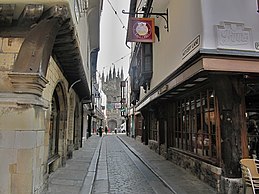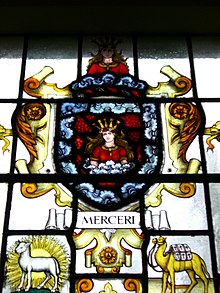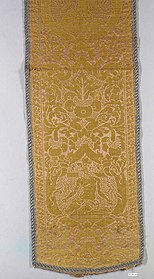Mercery

Mercery (from French mercerie, the notions trade) initially referred to silk, linen, and fustian textiles among various other piece goods imported to England in the 12th century.[1]
Mercery has a rich and complex interwoven history in London dating over 700 years. London was the major trade centre in England for silk during the Middle Ages and the trade enjoyed a special position in the economy amongst the wealthy.[2] The meaning of the term mercery later expanded to include goods made of these textiles and the sellers of such goods.
The basic operation was run most commonly by a family unit, consisted of the mercer, wife, family, servants, and apprentices. The husband was tasked with the duty of marketing and selling their wares to the public in places such as their small storefronts and in public fairs. The wife's duty in the workshop was to use her skills as a silk woman to buy the materials for their mercery trade and make the various silk cloths and piece goods; she was also in charge of the workshop alongside her husband and often would be expected to train the apprentices and children to contribute to the household income.[2]
Terminology[]
The term "mercer" for cloth merchants (from French mercier, merchant originally importing goods from the Eastern world[3]) is now largely obsolete.
Mercers were formerly merchants or traders who dealt in cloth, typically fine cloth that was not produced locally. Inventories of mercers in small towns, however, suggest that many were shopkeepers who dealt in various dry commodities other than cloth.[4] Related occupations include haberdasher, draper, and cloth merchant, while clothier historically referred to someone who manufactured cloth, often under the domestic system.
By the 21st century the word mercer was primarily used in connection with the Worshipful Company of Mercers, the first in precedence of the twelve Great Livery Companies of the City of London.[5]
Etymology[]
The earliest origins of term mercery was amorphous in nature and used to describe the sale of a wide range of goods, such as small items like needles and threads, and expensive raw materials such as silk or brocade. The term can be dated to the early 11th century. The first reference to mercery was used for foreign merchants from modern day Germany, France and Netherlands, who were well placed geographically to transport luxuries from the East and their own manufactured goods into England.[6]
Only in the 12th century did the term mercery as an occupation become distinctly separate from the general merchant who might only deal with linen, as mercery became associated with silk, linen, and various piecegoods, especially high quality offerings such as dress accessories, small luxuries and beddings – different from the simple everyday wear of the masses. It is the trade of silk and expensive clothes that set apart the profession of a mercer from that of a general merchant, under the trade regulation on London which, as a major trading hub of that time, which was sufficiently extensive as to allow certain goods to be clearly defined as mercery – wherein in laws specifically aimed to control prices and protect local mercers through supply and demand.[6]
The mercery in London[]

Whilst London is closely intertwined as the prominent hub of the mercery trade in England throughout the Middle Ages, before the 12th century goods such as silk, linen and fustian in England primarily implied overseas trade, wherein only linen was produced and sold in England.
The origins of the mercery trade further developing from just an import market in England is tied into the history of trading, manufacturing, and distribution standards in the Middle Ages. The establishment of recognised trade routes over time and new financial systems such as credits being available in the main cities of trades for merchant and bankers alike, helped the expansion of the domestic mercer trade in London.[6]
Bundles of raw silk was brought into London from Italy for silkwomen to make into piece goods such as laces or braids and for embroidery. This mercery market continued all throughout the Middle Ages, wherein Londoners who used rely heavily on Italians to bring Silk into London the 12th century – now had avenue wherein they could establish direct contact with Italian and other foreign suppliers at major trade fairs in places such as northern France.
Fustian reached London through the same trade routes dominated by Italy in the 12th century; originally an ancient cloth from the Middle East made up from flax and cotton, it was replicated in Italy and became increasing popular and a staple manufacture for mercers to profit from. In addition to the increased cultivation of Flax in Europe, linen was become a symbol of wealth of the burgeoning middle class, wherein with innovation in the 11th century such as the treadle loom – the trade of materials such as linen and flax with increased supply was more popular than ever in London.[6][7]
Other than the trade and manufacture of expensive cloths, mercers were also concerned with a wide variety of piece goods which had a large market in London – as it was more affordable for commoners. These small goods were made from materials such as silk, linen and cheaper substitutes such as fustian and hemp.[2]
History of the mercery in London[]
13-14th century: development of the mercery trade and The Black Death[]
The mercery trade in the 12th century was synonymous with the overseas trade of silk, linen, and fustian. In the first half of the twentieth century, most of the mercery textiles was brought over by foreigners. While silk cloth was only valuable to the nobility and the church, a wider variety of small piece-goods made from silk and linen had a much wider and more valuable market for mercers - silk was used enmasse for dress accessories and alike.
The creation of the Livery company for general merchants in 1394 was soon supplanted by the economic and societal detestation of the Black Death in the ranks of the company, over a third of its member died and the situation was bleak. However, the merchant's guild managed to not only survive the plague, but thrive in the oncoming economic revival that followed The Black Death only fifty years later. The groundwork for the mercers to thrive in a post-recession England economy was due to massive population losses, wherein wages rose due to lack of labour and with a considerably smaller populous, farmers could focus more on producing livestock and speciality crops instead of just grain – which improved peoples diets and health as a result. The general population was engaging more into the market economy with higher living standards present and their immediate needs taken care of. The company capitalised on this opportunity to expand as a driving force of the new England economy, wherein provincial towns previously not visited by mercers son became part of a complex and established market system of trade. In addition, to this the development of the mercery trade in the late 13th century was uniquely abetted by The Black Death, due to the drop in population – wherein post-recession ordinary men and women could afford to buy higher standards of clothing to dress themselves better.[6][8]
Religious and social change: The livery company for general merchants[]

The merchant trade guild would form into a livery company, which comprises London's most ancient and trade associations. The Worshipful Company of Mercers was formed by men and women of the same trade and functioned in a social and religious manner to benefit its members.
The English Reformation in the 15th century, created great social and economic upheaval for the Worshipful Company of Mercers. The mercers sought to benefit from the turmoil of the period and acquired one of many dissolved religious buildings by Henry VIII and gave a plead of fealty to the Protestant cause of the head of the Church being led by the King. Before power held by the clergy was transferred over to the aristocratic class of society, wherein powerful mercers had bureaucratic power to ensure a monopoly on the trade of silk – effectively displacing merchant who sought to sell their wares independently from the company.
This quick adaption of new changes in religion was quickly adapted by the mass of mercers, due to their nature of their trade – these young men would travel abroad to markets overseas and become more receptive to change and as a result easily influenced and accepting of new ideas.[9][10]
Prosperity of the mercery in 15th century[]
The prosperity for a merchant during this period was high. Their overseas trade was expanding, and they controlled the distribution of their goods to England's provinces. A greater merchant could seek to break himself from the ranks of artisans and shopkeepers to serve to an exclusive class of customers.[11]
During this period more mercers ascended from mere ‘merchants’ to aristocracy as they ascended their class as their fortune grew – into influential positions such as aldermen and mayors, wherein municipalities had significant power in the Middle Ages. Although the livery company for mercers still had discriminatory policies that benefitted those more senior, prosperity was within reach for all ranks to strive towards now more so ever than any other period of the company.[6][12]
This success for the common mercer can be attributed to the flourishing overseas trade that the Worshipful Company of Mercers engaged in, particularly in regions such as Northwestern Europe. The percentage of cloth exports of London mercers during that time was no less than 30%, and more importantly the company controlled the competition tightly – other merchants to attempted to sell materials such as silk, linen, fustian, wool and other piece goods independently.[6][7]
Fall of the medieval mercery trade in the late 16th century[]
The mercery trade began to lose its esteemed status in its retail, due to a failure to control its market. Independent retailers who were not part of the mercery found success in undercutting the Worshipful Company of Mercers (or "The Mercery Company"), compounded with the fact that recruitment had fallen due to fewer and fewer men partaking in the wealth held by the company.[2]
The downfall of the mercery trade as a once highly sought avenue to bridge the gap from the lower-class to upper-middle class was due to the negligence of The Mercery Company, who disrespected the common artisan and retailer, disregarding the foundations of their success in the working mercer and his wife, the average mercery unit of the mass. The company stopped promoting the importance of silk piece-goods in favor of more expensive opportunities. They stopped the focus on monopolizing linen as a primary form of revenue. The lack of introspection by the wealthy mercers into the struggle of the merchants who did not profit from the silk trade like the elite did caused the rapid loss of control of the textiles market.[6][7]
Examples of mercery piecegoods[]

The majority of piecegoods sold by mercers used silk as the basis to make a wide variety of dress accessories such as laces, loops and tassels. Dress embellishments could range from simple designs on the edge of sleeves to more extravagant designs made on bands called orphrey;– commonly used by the aristocracy and church.
Linen was used for shirts and underwear; silk and linen were made into headwear, from the ubiquitous coif worn by both sexes to women's wimples, and every variety of kerchief.
Headwear such as kerchief and wimples worn by women and the coif worn by both genders was also popular employment for a mercers services, silk and linen were primarily used for headwear.
An accessory that was ubiquitous for all classes was the pouch, which mercers sold in many different designs.
Other piece goods that mercers dealt with were manufactured from other materials, it ranged from pins and needles to bells and knives, which were bought less frequently when people had money to spare for useful trinkets. The Inventory of these items although not made of a fabric, was increasingly popular between the 11th and 13th century as mercers rich or poor could afford to produce them.[6]
Prominent mercers[]
- Wynne Ellis, 19th century British mercer
- Robert Large, (died 1441)
- Geoffrey Boleyn, 15th century English mercer
- Richard le Lacer, 14th century English mercer
- Charles Woodmason
See also[]
References[]
- ^ The Mercery of London, Anne F. Sutton, pg. 2
- ^ Jump up to: a b c d Sutton, Anne F. (2005). The Mercery of London : Trade, Goods and People, 1130-1578. London: Taylor & Francis Group. ISBN 9781315238326.
- ^ "Etymologie du mot "mercier"". Centre National de Ressources Textuelles et Lexicales. Retrieved 22 March 2020.
- ^ Europe's Rich Fabric: The Consumption, Commercialisation, and Production of Luxury Textiles in Italy, the Low Countries and Neighbouring Territories (Fourteenth-Sixteenth Centuries.) pp. 24–25.
- ^ https://www.mercers.co.uk/
- ^ Jump up to: a b c d e f g h i Sutton, Anne F. The mercery of London : trade, goods and people, 1130-1578. ISBN 978-1-315-23832-6. OCLC 1127323158.
- ^ Jump up to: a b c Belfanti, Carlo (2004). "Guilds, Patents, and the Circulation of Technical Knowledge: Northern Italy during the Early Modern Age". Technology and Culture. 45 (3): 569–589. doi:10.1353/tech.2004.0111. hdl:11379/24823. ISSN 1097-3729.
- ^ Wagner, Esther-Miriam; Beinhoff, Bettina (2017-01-08), "1. Merchants of Innovation: the languages of traders", Merchants of Innovation, Berlin, Boston: De Gruyter, ISBN 978-1-5015-0354-2, retrieved 2020-11-15
- ^ Arnold, Jonathan (2010-10-20). "Profit and Piety: Thomas More, John Colet, and the London Mercery". Reformation & Renaissance Review. 12 (2–3): 127–153. doi:10.1558/rrr.v12i2-3.127. ISSN 1462-2459.
- ^ Medievalists.net (2017-01-22). "A Family of Mercers in Medieval London". Medievalists.net. Retrieved 2020-11-15.
- ^ "INTRODUCTION", Medieval Mercantile Community, Yale University Press, pp. 1–5, ISBN 978-0-300-24222-5, retrieved 2020-11-15
- ^ Kathman, David (2011-10-13). "Players, Livery Companies, and Apprentices". Oxford Handbooks Online. doi:10.1093/oxfordhb/9780199697861.013.0025.
External links[]
- Textiles
- British clothing
- Clothing industry
- Sales occupations
- Economy of medieval England
- Mercers